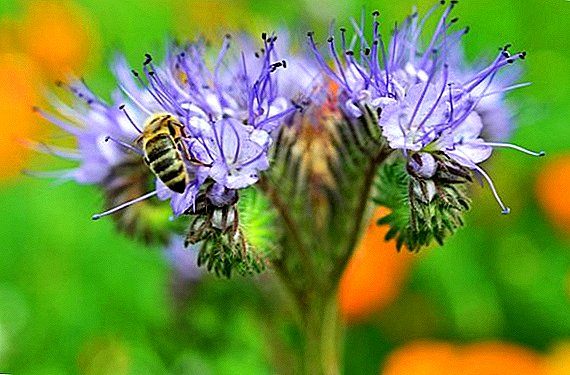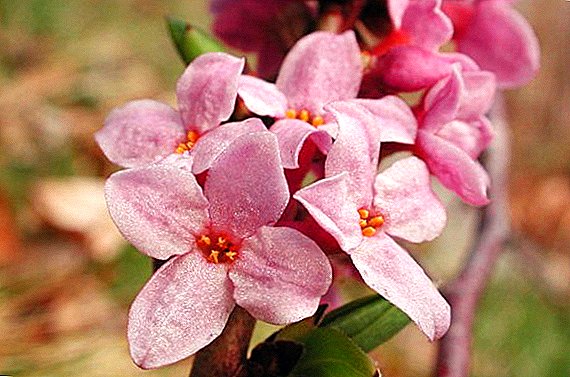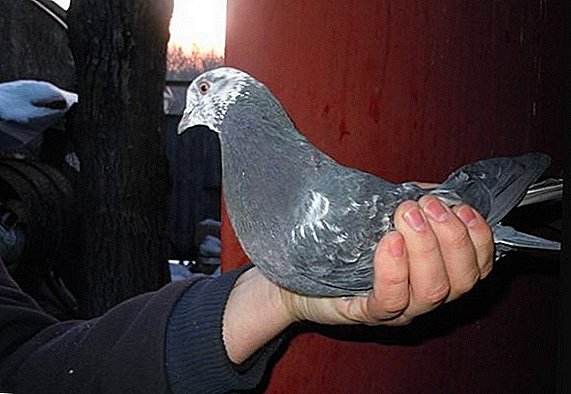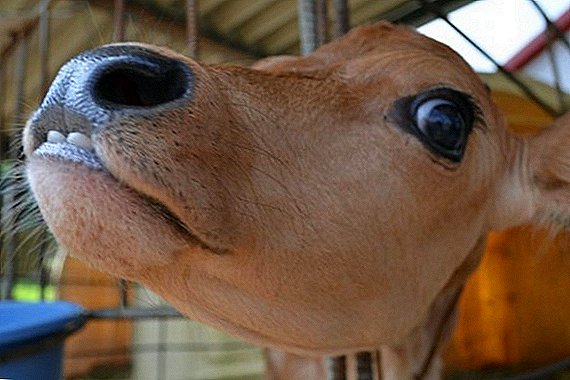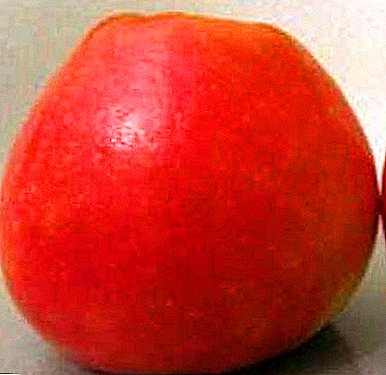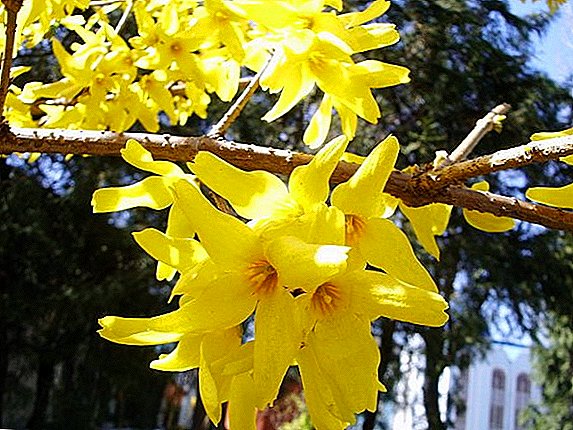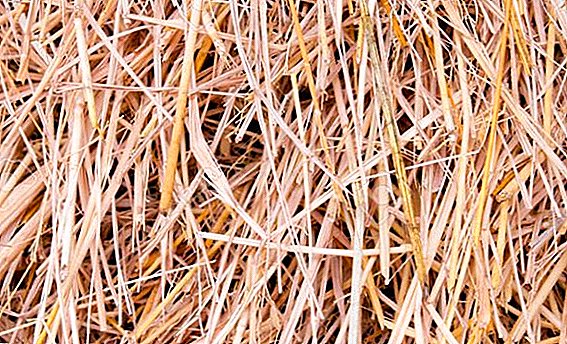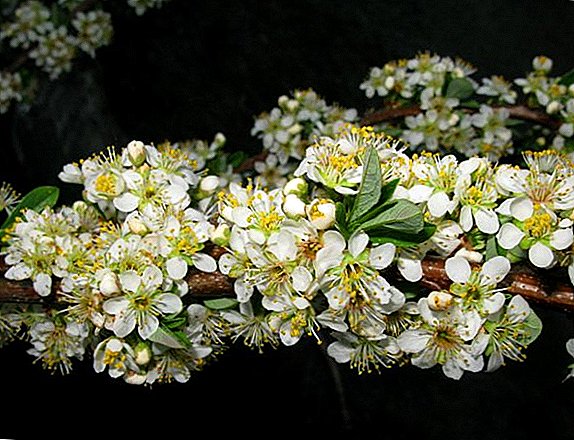 Bessey sandstone cherry is from North America. Here it grows on the banks of rivers and lakes, and sometimes it can even be found on the prairies. Graceful Bessey bushes can be the main decoration of any garden plot.
Bessey sandstone cherry is from North America. Here it grows on the banks of rivers and lakes, and sometimes it can even be found on the prairies. Graceful Bessey bushes can be the main decoration of any garden plot.
Thanks to a generous fruiting cherry has long won the confidence of many gardeners around the world. It is not demanding to care, has a high drought resistance, is indifferent to lowering the temperature and is able to bear fruit in the most severe conditions.
Bessey Cherry: Description
 All varieties of Bessey micro-cherries are compact in size. Cherry grows a bush consisting of upright shoots, reaching a height of not more than one and a half meters. The plant has thin reddish shoots, covered with reverse-lanceolate, slightly pointed leaves, reaching a length of no more than 5 cm.
All varieties of Bessey micro-cherries are compact in size. Cherry grows a bush consisting of upright shoots, reaching a height of not more than one and a half meters. The plant has thin reddish shoots, covered with reverse-lanceolate, slightly pointed leaves, reaching a length of no more than 5 cm.
In autumn, the leaves turn bright orange. Bessei has a rich flowering and generous fruiting. During the period of ripening, purple-black spherical fruits with a diameter of not more than 1 cm are formed on its branches, very tart to the taste.
Bessey has a reputation for excellent ornamental plants. This is explained by the fact that during flowering the whole bush is covered with a dense carpet of small white flowers with red stamens. In addition, on the same plant can be found female and male flowers.
The plant is very light-loving and demonstrates intensive development in comfortable conditions. Culture is absolutely not demanding on the composition of the soil, which allows it to be successfully grown on all types of soil.
What is sand cherry, varieties of bessey
Bessei was counted among the cultures in 1756. Due to the pronounced astringent taste, it was used primarily for decorative purposes, to protect the site from the winds, to attract songbirds, and as a medicinal plant.
 Recently, breeders have brought new varieties of Bessey cherries with high taste characteristics.
Recently, breeders have brought new varieties of Bessey cherries with high taste characteristics.
In the 19th century, Charles Bessie, a professor of botany from a North American university located in the state of Nebraska, described another kind of sand cherry, which was named after the scientist - Cerasus besseyi. Therefore, Bessey Cherry is just a subspecies of sand cherry. Botanists-taxonomists attributed Bessel to a variety of low sand cherry and called it Microcerasus pumila var.besseyi.
Did you know? Many landscape designers are actively using unleavened cherries to form hedges on the plots. It is also often used when it is necessary to improve the ornamental characteristics of a site where stony or sandy soil dominates.The gerbil cherries and bessey cherries are not real cherries. Both of them belong to the genus of microwaves and are close relatives of plums, and, besides this, they do not take root as a scion and do not intersect with real cherries. But on the other hand, they are perfectly crossed with plums, peaches and apricots, as well as some other types of fruit trees.
Features of growing sand cherry, the choice of location in the garden
Before you choose a place in the garden for bessei, you need to know where this cherry grows in its natural environment. In nature, the plant can be found near lakes and rivers in the prairies of North America. The culture is not too scrupulous about the soil, and therefore can be successfully cultivated on all types of soils.
 When choosing a planting site, preference should be given to sandy soils. It is not recommended to plant gerbil bushes too closely. It is desirable that the distance between 2 to 2.5 meters be maintained between bushes.
When choosing a planting site, preference should be given to sandy soils. It is not recommended to plant gerbil bushes too closely. It is desirable that the distance between 2 to 2.5 meters be maintained between bushes.
Bessey cherry seedlings are planted in the ground better in spring, since the time of planting of the crop coincides with the period of its active growth, which significantly increases the chances that the plant will take root well.
Important! When buying seedlings of cherry-gerbil in the fall, it is better not to rush to plant bushes in the open ground and prikopat them until spring. The fact is that the shoots that did not have time to acquire a well-developed root system before the onset of frost are likely to die.If you are counting on the generous fruiting of the seedless, then choose well-lit places for its planting. Despite the complete indifference of the cherry to the soil composition, it was noticed that the culture shows a more intensive development on sandy soils.
Climate requirements
Bessey's cherry grows throughout North America. And this continent is distinguished by a wide variety of climatic zones: here one can find a subequatorial, tropical, subtropical, temperate, subarctic and arctic climate. This characterizes a cherry to bessey as a plant with high adaptive abilities. 
The culture easily tolerates both drought and lowering the temperature to -50 ° C. Despite the ability to survive in extreme conditions, sand cherry will best feel in a temperate climate, at a temperature not higher than +24 ° С, but not lower than -16 ° С.
What should be the ground for planting a bessey
Cherry Bessey is not demanding on the composition of the soil, but most of all it is suitable for cultivation on sandy soils that have good drainage and aeration properties. Cultivation of "Bessey" is also possible on heavy clay or loamy soils; however, in this case, to improve drainage, it is recommended to use pebbles or small crushed stone, and to loosen some sand. In that case, if acidic soils dominate at the site, then to reduce the pH they are deoxidized with dolomite flour.
All about the proper planting sand cherry
Bessei seedlings are planted in the spring, but if you purchased sprouts whose roots are hidden in a closed container, they can be planted in early autumn or summer.
 When planting seedlings, it is imperative to take care of the organization of drainage, since stagnant moisture can cause infection of the roots with rot. Sand cherry saplings are characterized by increased root formation, and therefore they do not need additional use of root stimulators when planting.
When planting seedlings, it is imperative to take care of the organization of drainage, since stagnant moisture can cause infection of the roots with rot. Sand cherry saplings are characterized by increased root formation, and therefore they do not need additional use of root stimulators when planting.
How to choose a sapling
In order not to guess why the seedless seedlings did not take root, it is necessary to treat this event responsibly. Before buying carefully inspect the shoots. If sprouts are damaged or traces of infectious diseases, and their roots are heavily dried, then it is much more reasonable to refuse to buy such specimens. Damaged seedlings have lower adaptive abilities that will not allow plants to acquire a full-fledged root system.
Landing pit preparation
In general, Bessey cherry is completely unpretentious, but before planting a crop, it is recommended to familiarize yourself with some of its cultivation features. When you decide on the choice of landing site, you need to prepare the pit. Seedlings placed at a distance of at least 2 meters from each other, which will provide enough space for the bushes to develop. Then prepare a pit about 20 cm deep.
 At the next stage, a drainage hill consisting of broken bricks or rubble, which is covered with a 15-20 cm layer of soil mixture consisting of sand, humus, sod or garden soil in a ratio of 1x1x1, is arranged in the center of the pit, and a mixture of fertilizers consisting of equal parts is covered superphosphate, ash and compost.
At the next stage, a drainage hill consisting of broken bricks or rubble, which is covered with a 15-20 cm layer of soil mixture consisting of sand, humus, sod or garden soil in a ratio of 1x1x1, is arranged in the center of the pit, and a mixture of fertilizers consisting of equal parts is covered superphosphate, ash and compost.
How to plant a seedling Bessey
After preparing the pit, moisten the soil in it and place the cutting on the top of the drainage hill. Then shoots sprinkle with earth and lightly tamp the ground around them. After planting, the cuttings are watered with warm water. It is not recommended to use cold water for sprinkling sprouts, as this may cause infection of the roots with a fungal infection.
Sand Cherry Breeding Techniques
All varieties of sand cherries reproduce perfectly by cuttings, layering and seeds. In the second case, the seeds of the culture are isolated directly from the berries. If you plan to store planting material for some time, then this should be done not in plastic containers or plastic bags, but in glass or metal jars, the walls of which should not be eaten through by rodents.
Did you know? High humidity is a serious problem when sand cherry cherries bloom, and to increase the likelihood of pollination of a crop during a rainy summer, 20 g of honey in a liter of water should be diluted and sprayed with a mixture of bushes. The smell of honey will attract insects, which will contribute to the fertilization of plants.Bessey seeds have excellent germination, which allows you to get strong and healthy shoots, which will eventually turn into full-fledged bushes.
Seed propagation
 Reproduction of seedless seeds does not take much time. Seeds of culture in open ground are sown in spring or autumn after stratification, ensuring their more germinating.
Reproduction of seedless seeds does not take much time. Seeds of culture in open ground are sown in spring or autumn after stratification, ensuring their more germinating.
Stratification is an imitation of winter conditions. For stratification at home, it is best to use moss: it has excellent aeration and perfectly retains moisture.
First, the swollen seeds are placed on the moss in a previously prepared container and sprinkled with a thin layer of soil. In order for the seeds to germinate, they are placed in a dark place and exposed to temperatures ranging from +3 to +6 ° C.
When naklevyvanie happens, the temperature is reduced to 0 ° C, which will control their development and prevent untimely germination. Before planting in the soil, the seeds are heated for several days at a temperature not exceeding 18 ° C.
Cutting tree
The most popular breeding method for Bessey is by cuttings. To obtain planting material, young leafy shoots of cherries are cut into cuttings from 10 to 15 cm long. In the lower third of the shoot carefully remove all the leaves.
 Rooting cuttings carried out in conditions of high humidity and moderate ambient temperature in a special substrate. Shoots are planted in pre-prepared containers filled with soil mixture consisting of sod land, humus and sand, taken in equal shares.
Rooting cuttings carried out in conditions of high humidity and moderate ambient temperature in a special substrate. Shoots are planted in pre-prepared containers filled with soil mixture consisting of sod land, humus and sand, taken in equal shares.
Before rooting, the cuttings are recommended to be slightly shaded, which will protect them from the negative effects of direct sunlight. If you do it right, in 10 - 14 days the roots will appear on the shoots.
After this time, the cuttings are dug up and sent to the basement for wintering, having previously wrapped their roots in moist, but not wet moss. With the arrival of spring, the bushes are planted in a permanent place.
Reproduction by layering
Experienced gardeners often propagate Bessey by layering. In the spring, the lower branches are bent to the ground and fixed. After the shoots grow up, they are covered with a layer of earth mixed with humus, taken in equal parts. After the fall of the bushes foliage, the layering is separated from the parent bush and divided into parts with roots and planted in a permanent place. Cuttings are not recommended to be stored, as this reduces their adaptive abilities and slows down root formation.
How to care for sand cherry
Despite the fact that Bessey cherry is absolutely unpretentious, following simple rules for its planting and care will help grow healthy and strong plants that will constantly delight you with generous productivity. Caring for a crop does not take much time, because even if you do not water the bushes for several days, the plant will not disappear, as it has excellent drought tolerance. The culture is not sensitive to a decrease in temperature and has excellent immunity against most phytoinfections.

Important! Due to the fact that bessey is a self-bearing culture that does not need additional manipulations, in order to increase yields, it is necessary to plant several bushes nearby.For the normal formation of the bushes will need to periodically carry out their pruning, which will prevent aging and will maintain reproductive properties at the proper level. Systematic watering and periodic feeding will allow you to get a generous harvest every year.
Watering rules
When growing sand cherries do not rely on its natural endurance and rely on the fact that the plant can do without watering. The lack of moisture dramatically reduces the productivity of the culture. The organization of high-quality watering is especially important at the stage of fruit formation: Bushes that are chronically short of moisture produce smaller fruits.
No less dangerous is the cultivation of bessei in conditions of high humidity, as this may cause mold infection of the bushes. Watering the bushes is necessary when the upper layers of the soil have already dried out well by several centimeters, and also if it breaks down and does not hold the shape when trying to squeeze a clod of earth taken from under the bush.

How to care for the soil
In order for Bessey to grow and develop well, the bushes need to carry out simple agrotechnical measures:
- systematic weeding of the stalk territory and removal of weeds;
- loosening the stalk zone to improve the aeration characteristics of the soil;
- timely watering;
- periodic soil fertilizer.
Bessey Cherry Fertilizer Tips
Fertilization is carried out in early spring, before flowering. During this period, it is recommended to introduce potash or nitrogen-containing fertilizers into the soil, which will stimulate the development of greenery and enhance the growth of bushes. During the vegetative phase and flowering, you can please the plant with a solution of mullein and ash, which will contribute to the formation of larger fruits. After harvesting, before the onset of cold weather, you can increase the protective forces of plants by introducing complex fertilizers into the soil.
How to protect cherries from pests and diseases
In their natural habitat, sand cherry rarely suffers from diseases. However, when a plant is cultivated under conditions of high humidity, the probability of plant infection with fungal phytoinfections significantly increases. 
Fulfillment of simple rules will help prevent the development of fungal infections:
- removal of fallen leaves from the site in autumn;
- regular pruning of all damaged shoots;
- treatment of plants with 3% solution of ferrous sulfate before flowering;
- spraying the bushes before blooming buds with a 1% solution of Bordeaux mixture;
- treatment of wounds from gum therapy with garden pitch.
Bessey cherry is rarely affected by pest attacks; the fact is that at the flowering stage the plant produces an intense aroma that insects do not like very much.
Sand Cherry Pruning Rules
Pruning sand cherries is virtually no different from pruning other fruit crops. Pruning Bessi - the most important event that allows plants to develop properly and as long as possible to preserve their ability to fruiting.
Important! Remember that old gerbil cherry branches that have reached the age of six will give much less yield, and their fruits will be smaller and more tart.

The basic rules for the formation of Bessey cherry bushes:
- in the first year of life of seedlings, the shoot is cut 5–10 cm from the top;
- periodically remove branches that have reached the age of four from the plant, since it is the young shoots that generously bear fruit;
- increased bud formation is observed in shoots reaching a length of no more than 50 cm, and therefore try to leave branches of this size on the bushes.
Harvest
The culture ripens completely by the middle or by the end of August, but at the same time its fruits do not fall off on their own, remaining on the branches. Berries under the influence of sunlight gradually lose their astringency and slightly wilted, which significantly increases their taste characteristics and gives the taste some piquancy.

Bessey Cherry: Sandy Cherry Pros and Cons
Cultivation of a Bessey cherry has its advantages and disadvantages. So, what exactly attracts this culture of gardeners:
- possesses high decorative characteristics;
- has excellent productive potential;
- not susceptible to pest attacks and has excellent immunity against phytoinfections;
- It does not require special care;
- can grow well and bear fruit in fairly harsh conditions;
- It is characterized by high drought tolerance and the ability to tolerate a decrease in temperature to -50 ° C.
Besseya is an excellent culture that, in return for attention and care, will respond with a beautiful appearance and tasty fruits. And besides this, it perfectly survives in any climatic zone, thanks to which even those who live in the northern regions will be able to grow it in their gardens.


